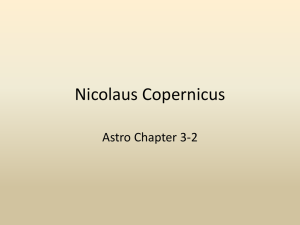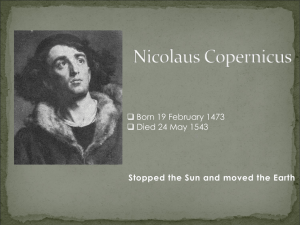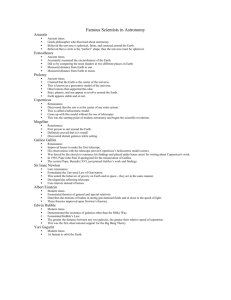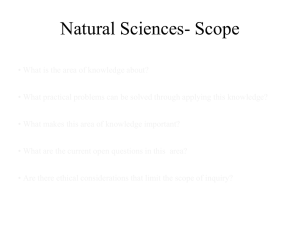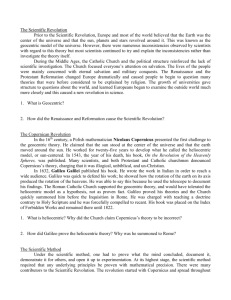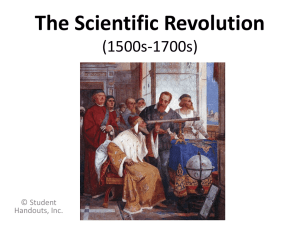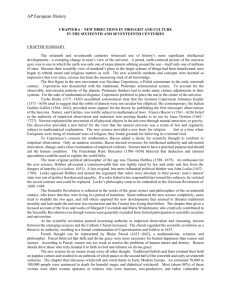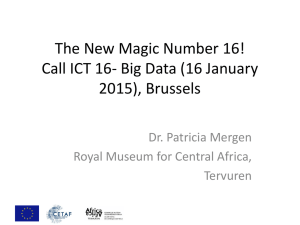Chap. 1 The Meaning of Copernicus
advertisement
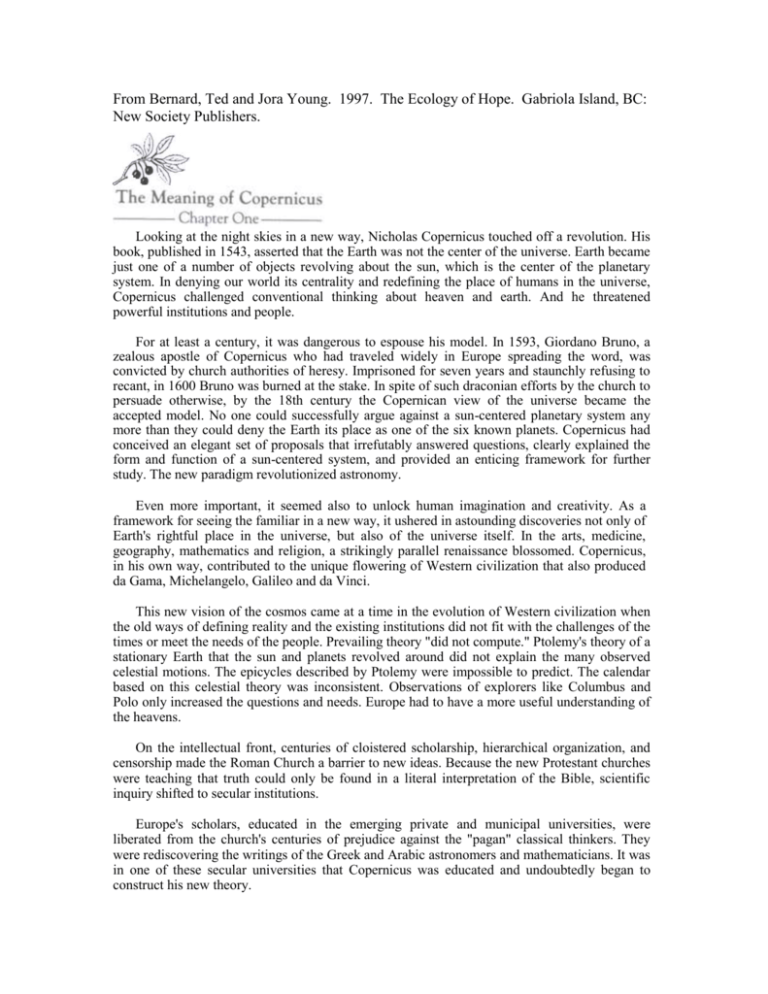
From Bernard, Ted and Jora Young. 1997. The Ecology of Hope. Gabriola Island, BC:
New Society Publishers.
Looking at the night skies in a new way, Nicholas Copernicus touched off a revolution. His
book, published in 1543, asserted that the Earth was not the center of the universe. Earth became
just one of a number of objects revolving about the sun, which is the center of the planetary
system. In denying our world its centrality and redefining the place of humans in the universe,
Copernicus challenged conventional thinking about heaven and earth. And he threatened
powerful institutions and people.
For at least a century, it was dangerous to espouse his model. In 1593, Giordano Bruno, a
zealous apostle of Copernicus who had traveled widely in Europe spreading the word, was
convicted by church authorities of heresy. Imprisoned for seven years and staunchly refusing to
recant, in 1600 Bruno was burned at the stake. In spite of such draconian efforts by the church to
persuade otherwise, by the 18th century the Copernican view of the universe became the
accepted model. No one could successfully argue against a sun-centered planetary system any
more than they could deny the Earth its place as one of the six known planets. Copernicus had
conceived an elegant set of proposals that irrefutably answered questions, clearly explained the
form and function of a sun-centered system, and provided an enticing framework for further
study. The new paradigm revolutionized astronomy.
Even more important, it seemed also to unlock human imagination and creativity. As a
framework for seeing the familiar in a new way, it ushered in astounding discoveries not only of
Earth's rightful place in the universe, but also of the universe itself. In the arts, medicine,
geography, mathematics and religion, a strikingly parallel renaissance blossomed. Copernicus,
in his own way, contributed to the unique flowering of Western civilization that also produced
da Gama, Michelangelo, Galileo and da Vinci.
This new vision of the cosmos came at a time in the evolution of Western civilization when
the old ways of defining reality and the existing institutions did not fit with the challenges of the
times or meet the needs of the people. Prevailing theory "did not compute." Ptolemy's theory of a
stationary Earth that the sun and planets revolved around did not explain the many observed
celestial motions. The epicycles described by Ptolemy were impossible to predict. The calendar
based on this celestial theory was inconsistent. Observations of explorers like Columbus and
Polo only increased the questions and needs. Europe had to have a more useful understanding of
the heavens.
On the intellectual front, centuries of cloistered scholarship, hierarchical organization, and
censorship made the Roman Church a barrier to new ideas. Because the new Protestant churches
were teaching that truth could only be found in a literal interpretation of the Bible, scientific
inquiry shifted to secular institutions.
Europe's scholars, educated in the emerging private and municipal universities, were
liberated from the church's centuries of prejudice against the "pagan" classical thinkers. They
were rediscovering the writings of the Greek and Arabic astronomers and mathematicians. It was
in one of these secular universities that Copernicus was educated and undoubtedly began to
construct his new theory.
While employed as an administrator for the Catholic Church in 1512, Copernicus began to
construct his new theory and test it with crude measurements. By the 1530s he was discussing
his findings with students and colleagues. He advanced the hypothesis that the known planets
were revolving around the sun and that the Earth, far from stationary and from the center of it all,
was rotating on its own axis, revolving in a fixed pattern within the planetary system. In short, he
concluded that the familiar night skies were not at all as they had seemed for centuries.
To make such claims, Copernicus realized, was a defiant act, and as he was employed by
the Catholic Church, he was reluctant to disseminate his proposals widely. Copernicus cautioned
his students against speaking out and did not publish his theories until late in his life.l Legend
has it he was handed a copy of his book, De Revolutionibus, just a few hours before his death.
He died without knowing his theories would become the most significant spark in a revolution of
profound importance. Like other revolutionary sparks, it was significant less for its own
incendiary power than for the flames it fanned. In time, the conflagration devoured Ptolemaic
thinking forever.
In the initial firestorm, Protestant theologians blasted Copernican thinking. Quoting passages
from Old and New Testament scriptures, Protestants condemned the inconceivable notion of a
universe not Earth- centered. They believed the human journey on Earth was but training for an
eternal afterlife. How could it take place anywhere but in the center? To think otherwise would
risk eternal damnation. Of Copernicus, Martin Luther exclaimed: "That fool will reverse the
entire astronomy; according to the Scripture, Joshua bade the sun and not the Earth to stand
still."2
The Copernican Revolution threatened Christianity on many counts. It forced the church to
reconsider not only humanity's relationship to the divine and to afterlife, but also its own limited
place in the universe. Humans could no longer presume themselves to be at the center of the
universe. Heaven could no longer be imagined as a glorious celestial dome arching above a
stationary Earth. Where was God in the new scheme of things? If the universe is infinite, where
is God's throne? "How is man to find God or God man?"3
Copernicus and his followers thus challenged the very cosmology of Christianity. The
Catholic Church ultimately banned De Revolutionibus, Copernicus and his followers were
branded heretics and atheists, they were excommunicated, and his followers were burned at the
stake. Galileo, the Copernican who most effectively confirmed and enlarged upon the system,
was twice condemned by the Inquisition and forever banished from the Catholic Church. Despite
inquisitions, bannings and burnings, the revolution could not be contained. It exposed too many
illogical explanations; it responded too successfully to questions and doubts; it unlocked too
many secrets; it opened too many vistas. It was just too useful to an expanding class of global
navigators. It became the new universe of Galileo and Newton and Einstein, a universe at the
core of our own vision of the night skies, a universe in which the Earth is surely not the center.
Nor is man.
This upheaval in Western thought- the Copernican Revolution -is a powerful metaphor.
Like most major transformations in the way humans think about the world, the Copernican
Revolution shattered beliefs at the core. Though its foundations were laid centuries before, like
most revolutions, it required a gifted and unconventional person to recast those foundations in
new ways, to see familiar objects with new eyes, and to translate everything into language
others could understand and take forward.
A small voice across a vast wilderness, Copernicus was at first heard by a few. Those few
had to hold on to the nascent vision while everyone -the big institutions, the clergy, the "powers
that be" -tried to obliterate it. Nevertheless, this new way of seeing familiar objects and of
connecting them to the unfamiliar was compelling. Individual by individual, the new way spread.
It set minds free, threw open doors for research and discovery, laid groundwork for the great new
structures of scientific inquiry, sparked a renaissance of action. The world would never be the
same.
Philosopher Thomas Kuhn, to whom we are much indebted for his interpretation of the
Copernican Revolution, tells us that this is the way all science marches forward.4 An old
framework, which holds center stage for a long time, begins to crumble. Inexplicable facts and
conflicting observations strain its credulity and create problems. Research scientists are in crisis.
There are too many puzzles. Science comes to a turning point. A new paradigm emerges to shed
light on the accumulated stack of puzzles. The new paradigm is incompatible with the old; their
differences are irreconcilable. Since the new effectively explains contradictions inherent in the
old, it gains ascendancy and becomes the framework by which everybody understands reality. It
becomes, in Marilyn Ferguson's words, a “sudden liberation from old limits."5
In the search for sustainable ways to manage the earth's natural resources, Kuhn’s
explanation of change and the metaphor of Copernicus has much to teach us. First, resource
management -the policies and practices governing natural resource allocation, development and
use – has come to a decisive place in history. The existing framework for making choices is not
solving present problems. It does not effectively explain observed phenomena nor does it give
good direction for future decisions. The present framework assumes that the earth's resources
exist largely for human use. It assumes that the earth is infinitely resilient and malleable and that
humans have ultimate dominion and sovereignty over all other life-forms and processes.
Thomas Berry explains how this happened:
We were the sane, the rational, the dreamless people, the chosen people of destiny.
We had found the opening to a more just society, a more reasoning intellectual life.
Above all we had the power to re-engineer the planet with our energy systems, our
dams and irrigations projects, our great cities. We could clear the forests, drain the
marshes, construct our railways and highways, all to the detriment of the other
living forms of earth, to the elimination of needed habitat, to the obstruction of
migration paths, to the cutting off of access to waterways. We could subdue the
wilderness, domesticate the planet. We were finally free from the tyranny of nature.
Nature was now our servant.6
This history seems to give us permission to manipulate any and all of earth's systems for the
"commodities" valued at any given time. If humans want to live and raise corn in the floodplains
of great rivers, those rivers should be diked and rerouted. If humans want ten times more
cellulose fibre from a forest than that forest can produce with its native configuration of species,
then we should remove all other species and grow only one type of "genetically improved" pine
tree where once a whole forest grew. If humans graze livestock on grasslands until all the grasses
have been consumed and soils waste away, then future generations will have to accept the
consequences of expanding deserts.
When this belief system is questioned, there are no small number of institutions and
individuals ready to quote scripture and hold fast to religious or legal rights and precedents. But
the questions cannot be put down. Thinking people cannot accept that there is nothing to worry
about:
when as many as 20 per cent of the earth's species is threatened with extinction
within the next century7
when almost half of the commercial shellfish beds in the U.S. could not be harvested in
1993 because of pollutions and most of the earth's fisheries are on the decline9
when the earth's deserts are expanding while its rich forests,
freshwater aquifers, and coral reefs are declining
when "impoverished" land is the fastest growing category of land use
in the world
when in spite of all this, even the basic needs of the people living on the earth today are
not being met and human population is growing exponentially.
Rational people can come to no other conclusion. The present framework does not work.
Earth's landscape is littered with failed projects, environmental debacles, unanswered questions,
impossible problems, and vast contradictions. Crises abound.
Thousands of people from all walks of life are calling for change. Resource management
professionals are risking their careers by questioning their organizations' methods,10 observers
and citizens are turning into activists calling for change,ll theologians and philosophers and
educators are begging us to reconsider our place in the scheme of things. Michael Frome implores
us to challenge the system;12 Matthew Fox asks that we "see the planet...as Original Blessing."13
As the living fabric of the earth becomes ever more frayed, many search for a new paradigm,
a paradigm of sustainability. Though we often refer to sustainability as a "new paradigm," it is
only partly so. Just as the insights of Greek philosophers and Arabic astronomers were lost in
the Dark Ages and rediscovered by Copernicus, so also have traditions of sustainability been
obliterated by the obsession of industrial societies with science and technology and control. This
obsession underlies resource management and conditions us to view ancient ways as primitive
and simplistic. As the new paradigm of sustainability emerges, there is renewed interest in
understanding the methods and uncoveting the wisdom of traditional resource managers. For in
ancient civilizations are examples of human resource use that did not profoundly interrupt
cycles of natural renewal.
The Copernican Revolution speaks to our generation in a second, even more profound, way.
Copernicus forced humans to reconceive the position both of their planet and of themselves.
Copernicus convinced the world of the radical idea that Earth is not the stationary center around
which all else revolves. A similarly radical idea must take hold in modern resource management.
Just as Earth is not the center of the universe, so also must we recognize that for humans to find
their way they must first realize where they are. They are not at the center of the living
cosmology of the Earth, they are not central and superior to all other parts of the planet. "We
need to realize," writes Father Thomas Berry, "that the ultimate custody of the earth belongs to
the earth."14
Endnotes
1. Colin A. Ronan, Changing Views of the Universe (New York: Macmillan. 1961), 88-91.
2.
.A.
Pannekoek, A History of Astronomy {London: George Allen and Unwin, 1961), 188.
3. Thomas S. Kuhn, The Copernican Revolution: Planetary Astronomy in the Development
of Western Thought {Cambridge: Harvard University Press. 1957). 134.
4. Thomas S. Kuhn, The Structure of Scientific Revolutions (Chicago: University of
Chicago, 1970), 92-110.
5. Marilyn Ferguson, The Aquarian Conspiracy: Personal and Social Transformation in
Our Time (Los Angeles: }.P. Tarcher, 1980), 26.
6. Thomas Berry, The Dream of the Earth (San Francisco: Sierra Club Books, 1988), 203.
7. E.O. Wilson, The Diversity of Life (New York: W. W. Norton, 1992), 277 .
8. World Resources Institute, World Resources 1994-95, A Report by the World Resources
Institute (New York: Oxford University Press, 1994), 38.
9. Lester R. Brown et al., Vital Signs 1993: The Trends That are Shaping Our Future (New
York: Norton, 1993), 32-33.
10. Paul Schneider, "When a Whistle Blows in the Forest," Audubon (January/February
1992),42-49.
11. Kirkpatrick Sale, The Green Revolution: The American Environmental Movement 19621992 (New York: Hill and Wang, 1993), 72-94.
12. Michael Frome, "Heal the Earth, Heal the Soul," Crossroads: Environmental Priorities
for the Future, ed. Peter Borelli (Covelo, CA: Island Press, 1989), 249.
13. Matthew Fox, Original Blessing (Salt Lake City: Bear and Company, 1983).
14. Berry, The Dream of the Earth, p. 35.
